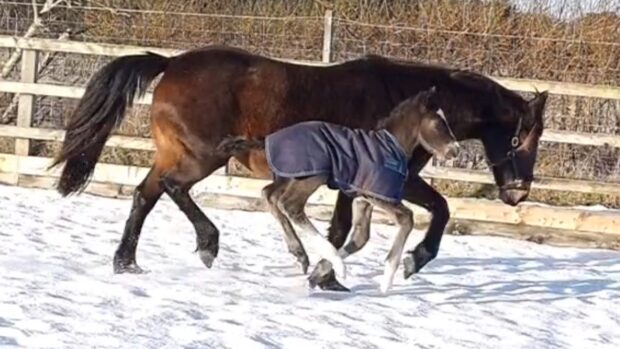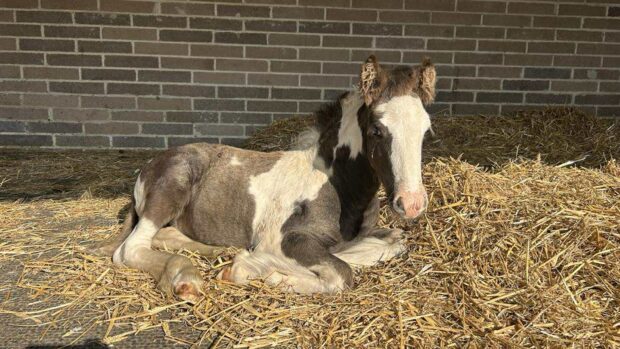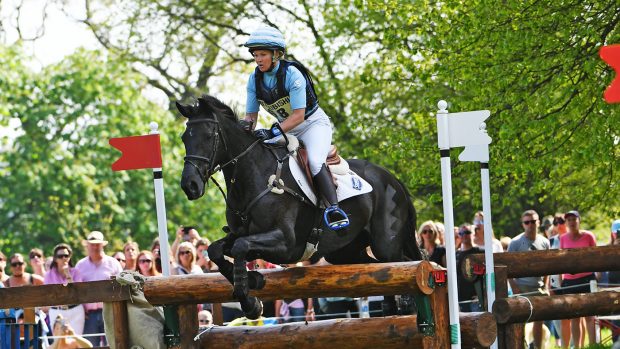When Jan Davidson and Ian Lovatt decided to breed a foal from ‘Larney’ (Seskins Popper), a mare they had owned for 16 years, little did they know the heartbreak and stress that was ahead.
Larney competed at British Eventing novice level with Jan, and then proved to be a super schoolmistress taking an inexperienced teenager to the national amateur showjumping championships at Aintree, where she won an accumulator class.
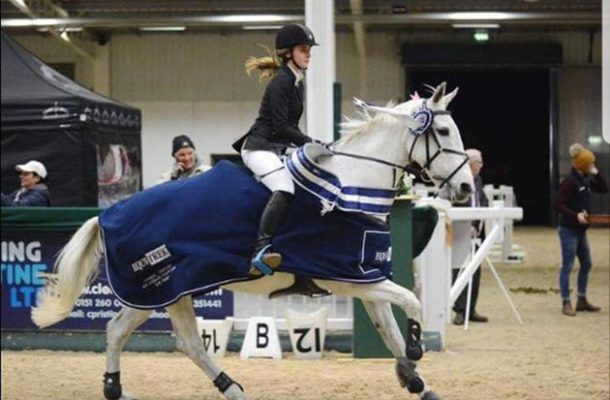
Larney
Jan and Ian chose the stallion Balou Star and sent her to Twemlows Stud. Larney was scanned in foal, due April 2018.
“Jan and I went along to the Twemlows open day, where Balou Star was paraded and jumped 1.60m for fun,” explains Ian. “He reminded us of another very good mare we have, Cyloma Z, and I said to Jan ‘I think that’s the one for us’.
“We went and asked the people looking after Balou Star if we could put our mare to him, but they said it wouldn’t work as he was only providing frozen semen — with a 20-year-old mare, a natural covering would give her the best possible chance of getting in foal.”
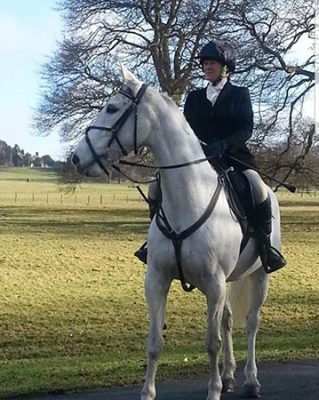
Larney
But after some discussion, it was decided that Larney would go to Twemlows to have fresh semen artificially inseminated once Balou Star had returned from a two-week jumping show in Germany.
“Twemlows called us two weeks later to say that a miracle had happened and Larney had been scanned in foal — we were over the moon,” says Ian.
Jan and Ian had wireless CCTV cameras installed in Larney’s stable, where she would foal at home, with Phil Wardle from the Bazaars Stud and Tom Walters Equine Vets on standby to help if needed.
On Thursday 19 April, Larney started to look uncomfortable. Phil came over and he recognised it was unlikely to be a straightforward foaling.
An internal scan showed the mare wasn’t creating enough room in preparation for the birth and things started to become desperate. But with Phil’s help, a healthy colt foal was eventually born.
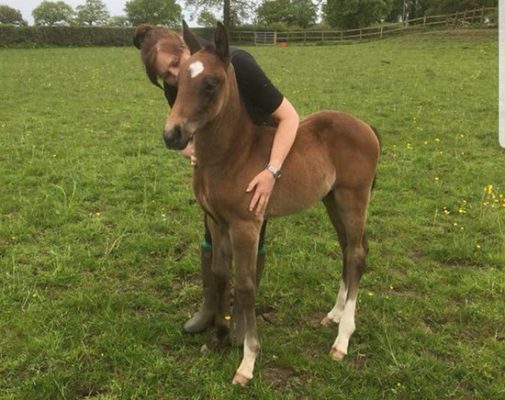
Larry
Shortly after the foaling, it became clear that Larney’s health was at risk and James Carrier from Tom Walters Veterinary practice attended. Despite everyone’s best efforts, the decision was made to put her to sleep. The focus was now on a foal to save.
“It was such a traumatic experience — Larney meant the world to us, but the race was now on to keep the foal alive,” says Ian.
While dealing with the emotion of having lost their wonderful mare, it was imperative to get Larney’s colostrum (first milk which contains important antibodies) inside her foal. Ian milked as much off Larney as he could.
“We had no experience of this type of situation before,” explains Ian. “The vet said we needed to milk Larney as much as we could — if the foal didn’t get the required amount of colostrum, he would die too.”
The newly named Larry was bottle-fed the colostrum, followed by formula milk every hour. It then became a race against the clock to find Larry a foster mum.
The National Foaling Bank was informed and Larry became the 38th foal looking for a foster mum that season.
Messages were put on Facebook and phone calls were made to studs and vets in the area.
“We had a massive response,” says Ian. “The Facebook post had over 1,000 shares and people were really there to help.”
The most suitable sounding match was found in Essex. The mare had tragically lost her own foal, but sounded ideal as she was an experienced mum, the right size, with plenty of milk and critically, she still had her dead foal with her.
Johanna Vardon from the National Foaling Bank advised Ian and Jan how to prepare for the tricky task of introducing the mare to Larry.
Firstly the stable was modified, dividing it into two with plywood and a mesh grill. The mesh needed to be no lower than the mare’s eye line so that she couldn’t touch noses with Larry. A plyboard gate was also installed to allow access between both sides of the stable, and finally Larry was kept hungry.
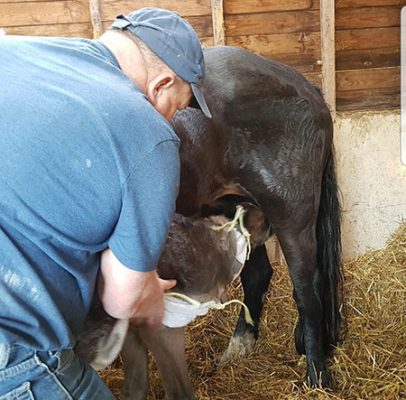
Larry learning to feed from KitKat with Ian’s help
After a four-hour journey, the mare, KitKat, arrived. She and her dead foal were put in the stable and she was milked by hand to relive the pressure in her bag and also to give some to Larry if required. The advice given was that once a foal has suckled his mum’s milk, he will begin to smell like her after 36-48 hours.
KitKat was then sedated so that her dead foal could be taken and his skin removed. The foal’s ears were also removed and tied to the grill between the stables on the mare’s side. This allowed her to smell her foal yet see Larry.
The skin was attached to a towel and placed on top of Larry covering his neck and back (pictured top). To add KitKat’s smell to Larry, her droppings and urine were rubbed all over him. Vicks Vapour rub was also placed on his head and in her nostrils to dampen her sense of smell.
The initial introduction over the stable door was encouraging with no signs of aggression from KitKat. Larry was backed into her stable, never allowing her to smell his head. Then it was time to get him to suckle. With a little assistance, Larry got the idea.
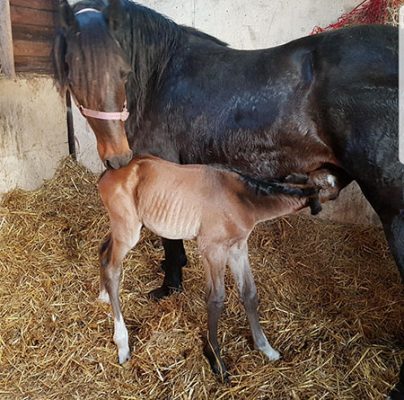
Larry and KitKat
KitKat was a natural. She was allowed to sniff his back and legs, but that was all for the time being. Once Larry was full, he was put back on the other side of the boards. KitKat immediately became distressed, which was a good sign but it was too early to leave them together — the fact that she could see him and smell the ears comforted her.
Two hours later, the process was repeated, and each feeding session was more and more encouraging, with the mare showing natural bonding signs such as licking Larry. The foal skin was slowly folded towards his head so that she could smell him.
At 6am Larry fed well independently and the skin was removed. KitKat licked and called out to him throughout. When he was put back into his box, the decision was made that he would be left with the mare after his next feed, and to everyone’s relief it was a success.
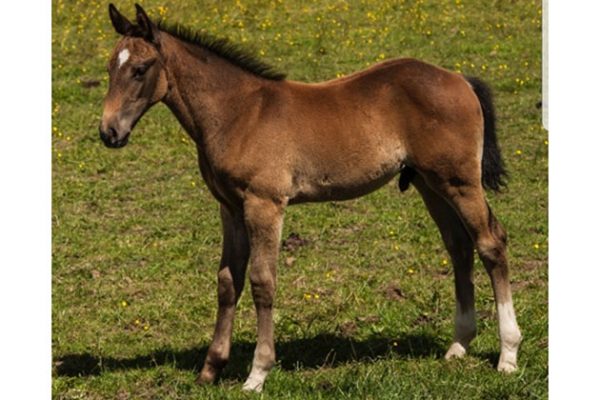
Larry
It is now a few weeks later and KitKat and Larry are both doing really well.
“I hope that even if this story raises awareness and helps just one person and their mare and foal, then speaking about it is worth it,” says Jan.
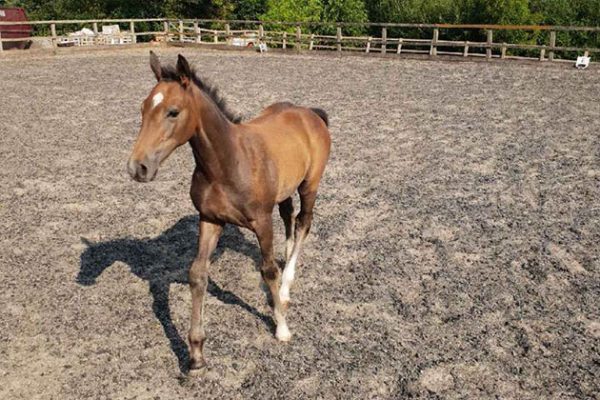
Larry on 26 July 2018
Ian says: “It was the worst few days of my life — Larney meant the world to us. But I would like to truly thank Edward from Twemlows, James from Tom Walters Vets and Phil Wardle for all of their expert advice. A special thank you must be said to Stuart Redding and Victoria Selfe for allowing their wonderful mare KitKat to come and save Larry’s life. Additionally they would like to thank their wonderful friends Helen, Mark, Tom, Bridie, Shirley, Darren and Ceri. The loss of their beloved Larney will never be forgotten, but hopefully now that she’s at rest, seeing a part of her living on inside Larry will in time help with the healing process.”
For all the latest news analysis, competition reports, interviews, features and much more, don’t miss Horse & Hound magazine, on sale every Thursday.


